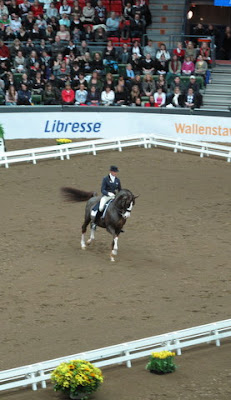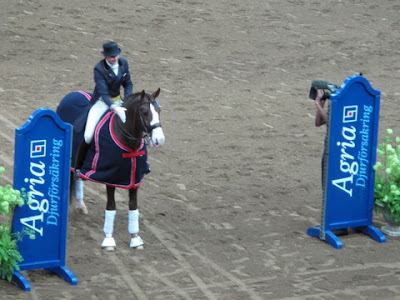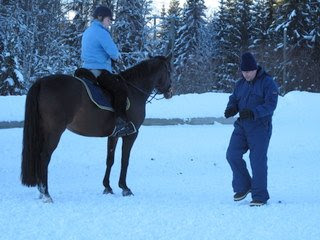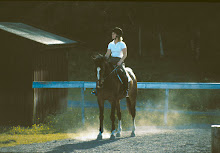 Björsells Briar and Jan Brink
Björsells Briar and Jan Brink
I'm a softie.
I suppose you have already guessed that.
I plod along in my little world, trying to make progress and trying to make the training enjoyable to my horse as well.
Trying to do my best, but not letting the ambitions take the fun out of the training, which I love.
I read a few blogs. Try to get some insight in other parts of the horse world
And WHAM.
My nice little horse-y world got rocked a bit.
On one of the blogs I’m following, Mugwump Chronicles, there have been discussions about horse abuse in shows, and abusive trainings methods.
Important theme, but not the most pleasant. You can read the first post
here.
Some of the stories have made me nauseous; I have had problems to get them out of my head. As I know zilch about horse life in the US (apart from what I read in the horse blogs) I have not the overall picture of what is going on. I assume the worst examples are just that. I know USA is a huge country.
It's just that I have never experienced something similar, and the stories really makes me upset.
And I wonder, have I led a sheltered horse life?
Is it not possible to get a horse to the top witout abuse?
So what have I seen? How does it work here?
OK. First my background:
I have never been working with horses professionally.
I have never had the talent or the means to make it to the top.
I have been riding for my whole life though, and have spent a considerable amount of time in a number of stables both in Sweden and Norway.
Scandinavia is a small corner of the world, I know that, but:
I have been fortunate as an adult to be instructed by GP-riders, including national team members.
I’ve watched them train.
I watch every clinic that I can.
I’ve attended clinics with several of the top riders in the dressage world.
I try and watch trainings when we have profiled trainers coming over.
Yes, I am a dressage nerd :-)
What I’ve seen in the form of abuse is yanking on the reins, some spur use and a few whip lashes, but I would not go as far as to put it in the real abuse category.
I can’t remember to have seen a horse with scarred mouth (at least on the outside, can’t say that I’ve looked inside), or with spur scars.
The shows/competitions here are regulated by FEI’s “Code of conduct”. It states in the first chapter that “In all equestrian sports the consideration to the horse comes first, and has never to step aside for commercial or competitional aspects”.
On all shows above local level there has to be – apart from the judges - a steward present.
The steward is to watch the warm-up pen and the facilities, and make sure that everyone behaves.
On shows at national level there is in addition a veterinary inspection before start.
The horses are not allowed to participate in shows/competitions until the age of 5 or 4 (the lowest classes existing)
I have never ever seen any abuse on shows apart from overuse of the whip, which has been addressed. And frankly, it has not been bad.
I have not seen what goes on "behind the scenes" at home with professional riders apart from the ones I know, but I have a good friend that has.
She has been working at one of the very top dressage stables in Germany.
I asked her for her story as well.
She said that in Germany she had experienced a couple of hard training sessions where the whip had been used more than she was comfortable with, but that was it.
No rollkur and almost no use of draw reins either.
So maybe I’ve not seen it all, but as there are dressage horses working on world top level until they are 17-18 years old, I would say that there are some people out there doing a good job.
I don’t believe you can keep your top-athlete performing at the top for so long if you don’t take good care of it.
An example of this is the best dressage horse in Sweden,
Björsells Briar, who participated in the Olympics and is now turning 18.
Parallel to competing he has been in stud use, an extra strain.
This horse has been participating in three Olympics, numerous WC and has been the highest placed breeding sire for six years in a row in the World Breeding Ranking for Sport Horses, managed by WBFSH (World Breeding Federation for Sport Horses).
A beautiful horse.
And sound.
Say that there is a difference.
Then I wonder why?
It is because of money?
As top horses and top results represent money in both sports, that should not make a difference.
Has it to do with traditions and culture?
Has it to do with what kind of tasks the horse has to perform in the different sports?
Is the male/female attitude towards horses making a difference? (As many female riders are into dressage I mean).
I wonder.
There are very few horses, talented enough to handle the demands on the top, when it comes to ability, health and mental attitude.
To have the horse working out of comfort zones is one thing, I agree that we sometimes have to do that.
Resorting to violence is another.
If the rider feels a need to resort to violence then I’d say it’s time to take a deep breath and control the frustration and anger.
I have always been told that “the fault lies above the saddle”.
So maybe it’s time to look at the exercise at hand and find out if the input above the saddle is causing the output below the saddle.
Maybe the rider hasn’t explained the task clear enough for the horse.
Maybe the horse is not strong enough.
Maybe the rider has to improve his/her skills.
Maybe neither the horse nor the rider is ready for the task on hands.
“Where the violence starts, the art ends”
I still believe this should be valid.
And remember; we are not speaking about problem horses here, we are speaking about horses in the top. Talented ones.
As well as talented riders.
Maybe that is the worst of it.
I just wanted to say, from my small corner of the world, that I believe that it should be possible to reach the top without abuse.
If not, we have gone astray.



 First, the dressage - and what warms my heart the most: Briar and Jan Brink.
First, the dressage - and what warms my heart the most: Briar and Jan Brink.
 And what a cool horse.
And what a cool horse. They came second.
They came second.
 The Shetlands pony Fonzie, his buddy the dog Mango and their owner Inger Hillskog Roth.
The Shetlands pony Fonzie, his buddy the dog Mango and their owner Inger Hillskog Roth.







































